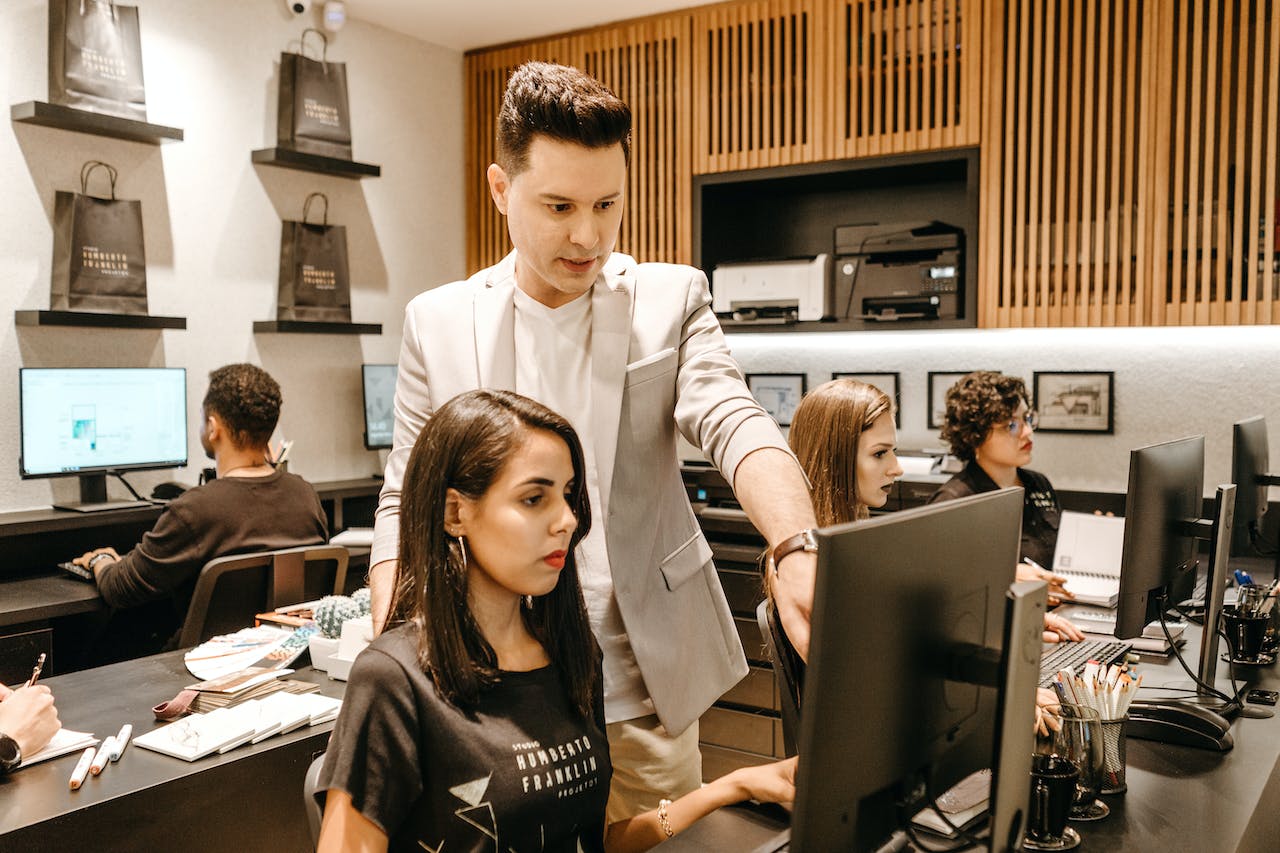
In the fast-paced landscape of today's business world, fostering innovation is not just a luxury but a necessity. Companies that encourage and support employees with big ideas often find themselves at the forefront of industry breakthroughs.
In this article, we'll explore the importance of How do you support employees with big ideas, supporting employees with innovative concepts and discuss practical strategies for cultivating a culture of creativity and empowerment.
The Significance Of Employee Innovation
In the dynamic and rapidly evolving landscape of the modern workplace, the significance of employee innovation cannot be overstated. The ability of employees to generate and implement novel ideas is a driving force behind organizational success and resilience. Here, we delve into the multifaceted importance of employee innovation and its far-reaching impact on businesses.
Competitive Edge In The Market
Innovation is a cornerstone of maintaining a competitive edge in today's markets. Companies that consistently introduce new and groundbreaking products or services are better positioned to capture the attention of consumers and outperform their competitors.
Employee-driven innovation ensures that an organization remains agile and responsive to changing market demands, creating a sustainable advantage in a crowded business landscape.
Enhanced Productivity And Efficiency
Employees with innovative mindsets often seek out more efficient ways of completing tasks and processes. By encouraging and supporting innovative thinking, organizations stand to benefit from increased productivity as employees identify streamlined workflows, implement automation, and find creative solutions to common challenges.
This boost in efficiency translates directly into cost savings and improved overall performance.
Adaptation To Industry Trends
Industries are subject to constant change driven by technological advancements, shifting consumer preferences, and evolving regulatory landscapes. Employee innovation equips organizations with the ability to adapt swiftly to these changes.
Forward-thinking employees who are encouraged to explore new ideas can help companies stay ahead of industry trends, ensuring they are well-prepared for future challenges and opportunities.
Employee Engagement And Satisfaction
Fostering a culture of innovation positively impacts employee engagement and satisfaction. When employees feel empowered to contribute their ideas and see those ideas implemented, it fosters a sense of purpose and ownership.
This engagement not only enhances job satisfaction but also contributes to employee retention, reducing turnover costs and preserving institutional knowledge.
Attraction Of Top Talent
Innovation is a magnet for top talent. Individuals seeking dynamic and forward-thinking workplaces are naturally drawn to organizations that value and prioritize innovation.
By establishing a reputation as an innovative employer, companies can attract high-caliber employees who are not only skilled in their respective fields but also bring a wealth of fresh perspectives and ideas to the table.
Creation Of New Revenue Streams
Innovative ideas often lead to the creation of new products, services, or even entirely new business models. Employees who are supported in their pursuit of big ideas can become the architects of diversification and expansion, opening up new revenue streams for the organization.
This ability to diversify and explore new markets is a crucial driver of long-term financial success.
Cultivation Of A Learning Culture
Innovation thrives in environments that embrace continuous learning. When employees are encouraged to explore, experiment, and learn from both successes and failures, it fosters a culture of continuous improvement.
This learning culture not only supports the development of individual skills but also contributes to the collective knowledge and resilience of the entire organization.
Positive Brand Image
Organizations that are synonymous with innovation enjoy a positive brand image. This perception extends to customers, investors, and partners, creating a favorable impression that can significantly impact brand loyalty and market reputation.
A positive brand image as an innovative company can also attract positive media attention, further enhancing the organization's visibility and credibility.
The Power Of Open Communication In Supporting Employee Innovation
In the dynamic landscape of the modern workplace, fostering innovation among employees is not merely a goal; it's a strategic imperative. At the heart of this endeavor lies the power of open communication—a fundamental catalyst for supporting employees with big ideas.
The question that often arises is, "How do you support employees with big ideas?" In this exploration, we delve into the transformative role that open communication plays in nurturing employee innovation.
Creating A Culture Of Accessibility
To truly support employees with big ideas, organizations must prioritize accessibility to leadership and decision-makers. Establishing an environment where team members feel comfortable expressing their thoughts without fear of hierarchy or judgment is essential.
Open communication channels, such as regular town hall meetings, suggestion boxes, and interactive forums, provide a platform for employees to voice their ideas and concerns. Addressing the question of, "How do you support employees with big ideas?" starts with ensuring that the avenues for communication are open, inviting, and genuinely inclusive.
Encouraging Transparent Dialogue
Transparent dialogue is the cornerstone of fostering innovation. Employees should be encouraged to communicate openly about their ideas, concerns, and aspirations. It involves not only listening to what employees have to say but also actively seeking their input.
Transparent communication ensures that the question of "How do you support employees with big ideas?" is met with genuine engagement and a commitment to understanding the unique perspectives and insights each team member brings to the table.
Feedback As A Two-Way Street
In supporting employee innovation, feedback is not a one-way street but rather a dynamic exchange. Providing constructive feedback on ideas and initiatives is crucial, but equally important is the willingness to receive feedback from employees.
This reciprocal process fosters a culture of continuous improvement, demonstrating that the organization values the input of its team members. Addressing the question, "How do you support employees with big ideas?" necessitates acknowledging that feedback is a collaborative tool for refining and strengthening innovative concepts.
Navigating Challenges Through Open Dialogue
Innovation is not without its challenges, and open communication plays a pivotal role in overcoming them. When employees encounter obstacles in the pursuit of their big ideas, having a forum to discuss challenges openly can lead to collaborative problem-solving.
Transparent communication channels provide the space for employees to share setbacks, seek advice, and collectively work towards overcoming hurdles. This proactive approach to addressing challenges aligns with the essence of supporting employees with big ideas.
Leadership's Role In Open Communication
Leadership sets the tone for the organization's communication culture. When leaders actively engage in open and transparent communication, it sends a powerful message that innovation is not only encouraged but is integral to the company's ethos.
Leaders can reinforce their commitment to supporting employees with big ideas by consistently communicating the value placed on innovation and emphasizing how each team member contributes to the organization's success.
Training Programs For Big Idea Development
In the pursuit of fostering a culture of innovation, organizations are increasingly recognizing the importance of investing in employee growth. A key avenue for achieving this is through comprehensive training programs designed to nurture extensive idea development.
So, how do you support employees with big ideas? The answer lies in strategic investments in training initiatives that not only enhance skills but also empower individuals to bring their innovative concepts to fruition.
Strategic Alignment Of Training Initiatives
To effectively support employees with big ideas, organizations must align training initiatives with the overarching goals of innovation. It starts with a clear understanding of the skills and knowledge required to drive innovative projects. Training programs should not only focus on technical skills but also encompass areas such as creative thinking, problem-solving, and collaboration.
Fostering A Continuous Learning Culture
Investing in employee growth goes beyond one-time training sessions; it involves fostering a continuous learning culture. Organizations that prioritize ongoing education create an environment where employees feel encouraged to explore new ideas and stay abreast of industry trends.
This culture of continuous learning directly contributes to supporting employees with big ideas by providing them with the knowledge base needed for innovative thinking.
Tailored Programs For Individual Development
Recognizing that each employee brings unique strengths and areas for growth, organizations should offer training programs that can be tailored to individual needs. Personalized development plans enable employees to focus on specific skills relevant to their roles and the pursuit of big ideas.
Practical Application Of Knowledge
Training programs should not exist in isolation; they must provide opportunities for the practical application of acquired knowledge. Incorporating real-world projects, case studies, and hands-on exercises into training initiatives ensures that employees can directly apply what they've learned to their day-to-day responsibilities.
By doing so, organizations bridge the gap between theoretical knowledge and practical implementation, supporting employees with big ideas in translating their learning into impactful innovations.
Encouraging A Growth Mindset
Investing in employee growth is not only about acquiring new skills but also about cultivating a growth mindset. Employees should be encouraged to embrace challenges, view failures as opportunities for learning, and persist in the face of setbacks. Training programs that emphasize the development of a growth mindset contribute to creating a resilient and innovative workforce.
Creating Spaces For Employee Creativity And Exploration
In the ever-evolving landscape of business, the concept of innovation hubs has emerged as a powerful strategy for fostering employee creativity and exploration. So, how do you support employees with big ideas?
The answer lies in the deliberate design and implementation of innovation hubs—dedicated spaces that serve as incubators for inventive thinking, collaboration, and the development of groundbreaking concepts.
Physical Spaces That Inspire Creativity
Innovation hubs are physical environments intentionally crafted to inspire creativity. These spaces are more than mere offices; they are dynamic ecosystems designed to break away from traditional workplace norms.
By offering employees a change of scenery and a break from routine, innovation hubs encourage fresh perspectives and unconventional thinking.
Equipped With Cutting-Edge Technology And Tools
Creating spaces for employee creativity involves more than aesthetics—it requires providing the right tools for the job. Innovation hubs are equipped with cutting-edge technology, creative software, and collaborative tools that empower employees to bring their big ideas to life.
By investing in state-of-the-art resources, organizations demonstrate a commitment to supporting employees with big ideas through the provision of the necessary technological infrastructure.
Encouraging Cross-Functional Collaboration
Innovation hubs are inherently collaborative environments that facilitate cross-functional collaboration. Breaking down silos between departments, these spaces encourage employees from diverse backgrounds and expertise to come together.
Innovation hubs serve as meeting points for individuals with different perspectives, sparking the cross-pollination of ideas and the synthesis of diverse expertise.
Flexible Spaces For Varied Workstyles
Recognizing that creativity knows no bounds, innovation hubs are designed to cater to diverse work styles. Whether employees thrive in open, collaborative spaces, prefer quiet corners for focused work, or need areas for group discussions, innovation hubs provide a range of environments.
This flexibility ensures that employees can choose the setting that best suits their creative process.
Promoting A Culture Of Exploration And Risk-Taking
Innovation hubs inherently promote a culture of exploration and risk-taking. These spaces serve as safe zones where employees are encouraged to step outside their comfort zones and experiment with new ideas.
Innovation hubs provide an environment where failure is viewed as a valuable learning experience rather than a setback, fostering a mindset conducive to innovative thinking.
Community-building And Networking Opportunities
Beyond physical spaces, innovation hubs serve as hubs of community-building and networking. Events, workshops, and networking sessions hosted within these spaces create opportunities for employees to connect, share ideas, and collaborate on projects.
A Culture Of Risk-Taking In The Workplace
In the quest to foster innovation, one of the pivotal strategies is cultivating a culture that embraces experimentation and risk-taking. So, how do you support employees with big ideas?
The answer lies in fostering a workplace environment that not only tolerates but actively encourages experimentation—a culture where taking calculated risks is seen as a pathway to growth, learning, and the development of groundbreaking ideas.
Creating A Safe Space For Exploration
To support employees with big ideas, organizations must first establish a safe space for exploration. It involves creating an environment where employees feel secure in expressing unconventional thoughts and testing innovative concepts. In doing so, organizations lay the foundation for a culture that values bold exploration.
Promoting A Growth Mindset
Encouraging experimentation goes hand in hand with promoting a growth mindset among employees. This mindset shift involves viewing challenges as opportunities for learning and growth rather than insurmountable obstacles.
Providing Resources For Testing Ideas
To truly support employees with big ideas, organizations must provide the resources necessary for testing and refining those ideas. It may involve allocating budgetary resources, offering access to specialized equipment, or dedicating time specifically for experimental projects.
Requires a tangible commitment to providing the infrastructure that enables employees to turn their innovative concepts into tangible outcomes.
Celebrating Learning Opportunities From Failure
In a culture that encourages experimentation, failure is not seen as a setback but as a valuable learning opportunity. Organizations should actively celebrate and extract lessons from failures rather than stigmatizing them.
Recognizing And Rewarding Risk-Taking
A culture of experimentation should be accompanied by recognition and rewards for those who take risks and push the boundaries of conventional thinking. Acknowledging employees who demonstrate a willingness to experiment and take calculated risks reinforces the organization's commitment to fostering innovation.
Encouraging Cross-Functional Collaboration In Experimentation
Experimentation becomes more potent when it involves diverse perspectives and expertise. Encouraging cross-functional collaboration in experimental projects brings together individuals with varied skills and backgrounds.
10 Ways To Improve Employee Engagement
Consider Job Design (and Redesign)
Job design plays a pivotal role in employee engagement. Evaluate and, if necessary, redesign roles to align with employees' skills and interests. Strive for a balance between challenging tasks and manageable workloads to enhance job satisfaction.
Clearly defined roles with achievable goals contribute to a sense of purpose and fulfillment.
Empower Employees And Help Find Meaning
Empowerment fosters a sense of ownership and purpose. Encourage employees to take initiative, make decisions, and contribute to the organization's goals.
Help them understand the broader impact of their work, connecting individual efforts to the overarching mission. This connection to purpose enhances motivation and engagement.
Build Trust
Trust is the foundation of a positive work environment. Foster open communication, transparency, and reliability. Demonstrate trust in your employees by delegating responsibilities and acknowledging their expertise.
A trusting workplace culture encourages collaboration and empowers employees to contribute their best.
Provide Regular Feedback And Support Growth & Learning
Regular feedback is crucial for employee development. Offer constructive feedback and recognition for achievements. Support continuous learning and growth opportunities through training programs, mentorship, and access to relevant resources. An environment that values and invests in employee development boosts engagement.
Support Employees Holistically
Recognize that employees have lives beyond the workplace. Support their overall well-being by offering flexible work arrangements, promoting work-life balance, and providing wellness initiatives. Addressing employees' holistic needs contributes to a healthier, more engaged workforce.
Try Gamification In The Workplace
Introduce gamification elements to make work more engaging. Implementing game-like features, such as challenges, rewards, and friendly competition, can enhance motivation and create a more enjoyable work experience. Gamification adds an element of fun and excitement to daily tasks, fostering a positive work atmosphere.
Recognize And Reward Employees
Acknowledging and rewarding employees for their efforts is a powerful engagement tool. Implement a recognition program that highlights achievements, both big and small. Personalized recognition reinforces the value of employees' contributions, boosting morale and job satisfaction.
Get To Know Your Employees On A Deeper Level
Building personal connections with employees contributes to a positive workplace culture. Take the time to understand their interests, strengths, and career aspirations. This knowledge allows you to tailor leadership approaches, provide targeted support, and create a more personalized employee experience.
Access Tools & Resources
Equip employees with the tools and resources necessary for success. Ensure they have access to up-to-date technology, relevant training materials, and a supportive work environment. Providing the right resources empowers employees to perform their best and contributes to overall job satisfaction.
How Do You Support Employees With Big Ideas?
Supporting employees with big ideas is a crucial aspect of fostering innovation and driving organizational growth.
By actively nurturing a culture that values creativity, collaboration, and continuous improvement, organizations can empower their workforce to contribute transformative concepts. So, how do you support employees with big ideas? Here are key strategies to consider:
Cultivate A Culture Of Open Communication
Foster an environment where employees feel comfortable expressing their ideas without fear of judgment. Encourage open dialogue through regular team meetings, brainstorming sessions, and anonymous suggestion boxes. By creating channels for transparent communication, you set the stage for the free flow of creative concepts.
Provide Resources For Skill Development
Invest in training programs and professional development opportunities that enhance the skills relevant to innovative thinking. Equip employees with the knowledge and tools they need to develop and implement their big ideas effectively. This commitment to skill development demonstrates a tangible investment in their growth.
Allocate Dedicated Time For Innovation
Recognize the importance of giving employees the time to explore and develop their big ideas. Set aside dedicated hours or specific projects that allow individuals to focus on innovation without the constraints of daily tasks. This allocation of time communicates the organization's commitment to nurturing creativity.
Create Incentive Programs
Implement incentive programs that recognize and reward employees for their innovative efforts. Whether through monetary rewards, promotions, or special recognitions, incentives provide tangible acknowledgment of the value placed on big ideas. It not only motivates individuals but also establishes a culture that celebrates innovation.
Build Cross-Functional Teams
Encourage collaboration across different departments and functions. The synergy of diverse perspectives often leads to more robust and innovative solutions. By building cross-functional teams, you create a platform for employees to leverage a variety of skills and experiences in the pursuit of big ideas.
Establish Innovation Hubs Or Spaces
Designate physical or virtual spaces specifically dedicated to innovation. These hubs provide employees with an environment tailored for creative thinking, equipped with the necessary tools and technology. Innovation spaces serve as incubators for big ideas, fostering a culture where creativity is nurtured.
Encourage Experimentation And Risk-Taking
Create a culture that views experimentation as a valuable part of the innovation process. Encourage employees to take calculated risks and explore unconventional ideas.
Celebrate not only successful outcomes but also the learning opportunities that arise from failures. This mindset shift supports a culture of resilience and innovation.
Provide Recognition For Contributions
Actively acknowledge and celebrate employees who contribute big ideas. Publicly recognize their efforts through internal communications, newsletters, or company-wide meetings.
Highlighting individual and team achievements reinforces the importance of innovative thinking within the organization.
Foster Psychological Safety
Establish an environment where employees feel psychologically safe to share their ideas, even if they are unconventional or challenging.
When employees trust that their contributions will be met with openness and support, they are more likely to share and explore big ideas without hesitation.
Lead By Example
Leadership plays a crucial role in setting the tone for innovation. Leaders should actively participate in the creative process, demonstrate a willingness to take risks and showcase their support for employees' big ideas. Leading by example reinforces the organization's commitment to fostering innovation at all levels.
Frequently Asked Questions
How Do You Encourage Employees To Speak Their Minds?
Check in and give feedback regularly. Use 360-degree feedback to encourage employee feedback. Take surveys and quizzes to receive feedback and a pulse on the company. Suggest staff journal their work.
What Role Does Trust Play In Supporting Employees With Big Ideas?
Trust is foundational in supporting employees with big ideas. A culture of trust, built on open communication and reliability, encourages employees to share their innovative thoughts without fear of judgment. When employees trust that their ideas are valued, they are more likely to contribute to the organization's innovative endeavors.
How Do You Teach A Growth Mindset To Employees?
- Embrace perseverance and hard effort over talent.
- Teach staff new skills.
- Promote new concept testing.
- Utilize setbacks for learning.
- Encourage workers to admit faults.
What Is The Best Way To Support An Employee?
- Give workers fair pay and benefits.
- Develop and teach professionals.
- Develop leaders.
- Focus on mental fitness.
- Establish mental security.
- Make people feel included.
What Role Does Leadership Play In Answering The Question, "How Do You Support Employees With Big Ideas?"
Leadership sets the tone for supporting employees with big ideas. When leaders lead by example, encourage risk-taking, and provide the necessary resources, they create an environment where innovation is not only valued but actively promoted. Leadership commitment is integral to fostering a culture that nurtures and celebrates big ideas.
Wind-up
Supporting employees with big ideas is not just about recognizing the importance of innovation but actively creating an environment that fosters creativity, provides resources, and rewards impactful contributions.
By fostering open communication, embracing diversity, providing necessary resources, recognizing and rewarding innovation, building collaborative environments, and supporting risk-taking, companies can cultivate a culture of innovation that propels them to new heights.
In doing so, they not only empower their employees but also position themselves as leaders in an ever-evolving business landscape. How do you support employees with big ideas? The answer lies in the deliberate cultivation of a workplace culture that values and nourishes innovation at every level.






